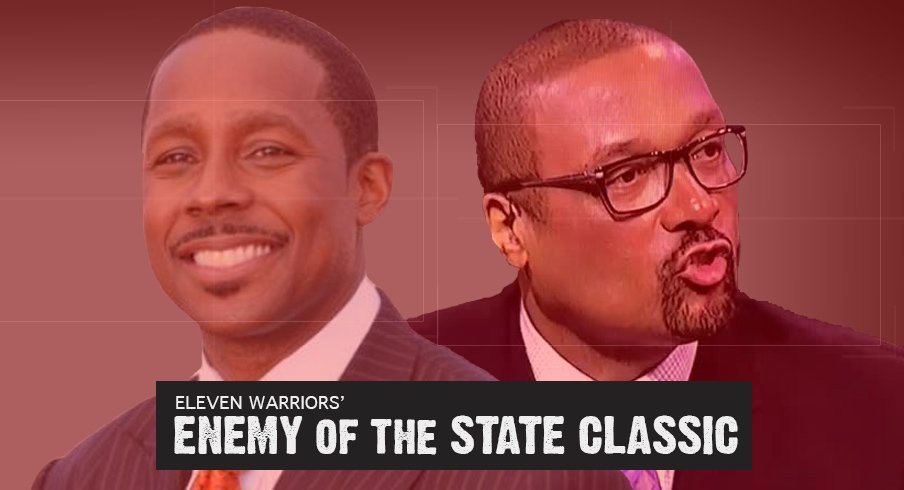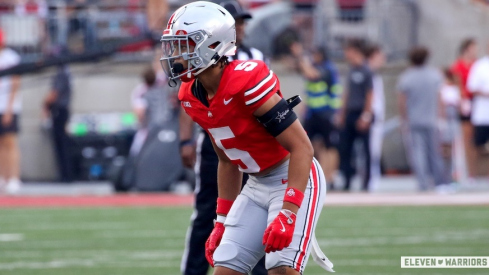Help us crown Ohio State's greatest villain. We begin with the Michigan Men region.
There are no shortage of villains in the Michigan Men region of our Enemy of the State Classic. From a legendary coach who left his home state only to break its heart, to players that have done the same, and others that were just plain awful humans, the arrogance in this region is overwhelming.
Other open rounds:
No. 1 Bo Schembechler vs. No. 8 Taylor Lewan
Glen Edward “Judas Iscariot” Schembechler’s crimes against the great state of Ohio need no introduction, but we’d be remiss not to run a refresher course for our youngest readers. Michigan’s iconic coach started out as a player under Woody Hayes at Miami University. After two successful stints as an assistant and a graduate’s degree at Ohio State the natural born Ohioan left to become head coach in Oxford.
Two years after being named Ohio Coach of the Year, Michigan athletic director Don Canham hired Bo Schembechler with a handshake.
“Bo, I’m offering you the job,” Canham reportedly said.
“Good,” Michigan’s newest coach replied.
Bo would go onto post a 194–48–5 record at Michigan, including the historic 1969 upset of an undefeated Ohio State in Ann Arbor. Though he would never win a national title in his 21 years leading Big Blue, Schembechler became Woody Hayes’ 10 Year War nemesis, and the de facto Public Enemy No. 1 for a generation of Buckeyes.
Taylor Lewan, in many ways, is the 21st century Michigan Man. In five seasons in Michigan, the two-time Offensive Lineman of the Year went 1-4 against Ohio State.
Some might wonder how a guy with one W in five tries and who once declared, “All I’ve known at Michigan is failure,” can possibly be considered a villain. That’s because Lewan, for lack of better words, was an insufferable dickhead during his time in the Maize and Blue.
In fact, his most notable victory over Ohio State came in the aftermath of Michigan’s on-the-field-loss to OSU in 2013, when a drunken Lewan sucker-punched a Buckeye fan at an Ann Arbor bar. In typical Michigan fashion, it ended with Lewan taking a plea deal on an assault charge.
Lewan will likely exit with a hard L from this tournament, but there’s something to be said about being the most grating Michigan Man of a generation.
No. 2 Charles Woodson vs. No. 7 Horace Greeley Prettyman
For anybody familiar with the backstory of Michigan football, it comes as no surprise that Michigan’s greatest footballer is a product of Fremont, Ohio. That doesn’t, however, make his career any less painful to Ohio State fans.
Woodson, a consensus top 50 high school product, finished his Michigan career as a two-time All-American, a Heisman winner, and a national champion, among a host of other awards.
In his three years at Michigan, the wine aficionado went 3-0 against his home-state Buckeyes, including two interceptions against a then No. 2 Ohio State in 1995 and a punt return and an end zone interception in 1997 to send Michigan to the Rose Bowl.
Michigan hasn’t been the same since he left.
The weight of Horace Prettyman’s sins depend on how much stock is placed into original sin.
The perfectly-named Michigan Man was actually born in Stryker, Ohio, in 1857, and by all accounts, was the first Ohioan athlete to commit his soul to Michigan athletics.
Unsurprisingly, Horace went onto become a pillar of Michigan’s program. Horace earned eight varsity letters, and captained Michigan’s team in 1884, 1885, and 1886. He also earned the distinction of scoring the first touchdown on Michigan’s Ann Arbor field.
No. 3 Desmond Howard vs. No. 6 Tim Biakabutuka
Desmond Howard, a quick-footed running back out of Cleveland St. Joe’s, never took an official visit to Ohio State due to Earl Bruce’s ouster and his not wanting to be a part of a rebuilding program. After considering Georgia Tech, Michigan State, Purdue, and Michigan, it was fellow Ohioan and then-Michigan assistant coach Gary Moeller who lured Howard to Ann Arbor.
After struggling at RB early, Michigan switched Howard to wide receiver, and it made all the difference. In three years in Ann Arbor, the All-American would go 3-0 against Ohio State. In 1991, the year he won the Heisman Trophy, Howard did this [TRIGGER WARNING].
Not satisfied with his enormities, Howard went into the media after his professional career ended. He has since been a generally insufferable Michigan homer.
Before Tim Biakabutuka happened, Ohio State’s 1995 campaign was a magical carpet ride for most of the season. After defeating No. 12 Penn State, 28-25, in Happy Valley, Ohio State won its next games by a combined score of 243-78.
Ohio State entered The Game in Ann Arbor with a No. 2 ranking and a shot at the national championship on the line. Michigan entered at No. 18 with a 9-3 record.
If Michigan wasn’t favored that day, its running back never got the message. Biakabutuka went nuclear.
To this day, it ranks as one of the greatest individual performances in the history of The Game. (Both teams went onto lose their bowl games.)
No. 4 Fielding Yost vs. No. 5 Jim Harbaugh
Fielding Yost, while not born in Ohio, was educated at what is now Ohio Northern University and started his coaching career at Delaware’s Ohio Wesleyan before being named Michigan’s head football coach in 1901.
In 25 years at Michigan, Yost went 198-35-12 and won six national championships and ten Big Ten titles. On top of that, Yost’s teams went 16-3-1 against Ohio State.
It’s thanks to Yost’s efforts that Michigan is still able to enjoy an all-time winning percentage against Ohio State.
Jim Harbaugh, Michigan’s Toledo-born coach would’ve probably been on this list even before he decided to take millions of Michigan’s money to resurrect the program that made him a household name. What he does with that job remains to be seen, but his crimes already extensive enough.
Harbaugh lettered all four years under fellow Ohioan Bo Schembechler, and the cantankerous signal-caller compiled a 3-1 record against Ohio State in that time.
In 1986, the year in which Harbaugh was named the Big Ten Player of the Year, he earned notoriety among Buckeye fans for guaranteeing — and delivering — a win against a then No. 7 Ohio State in Columbus.


